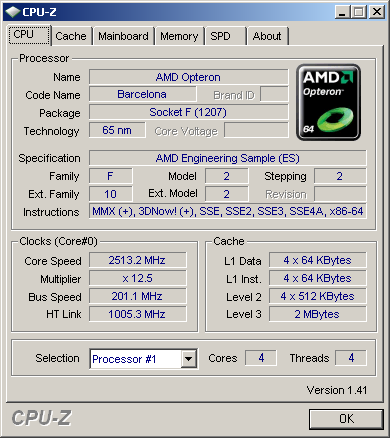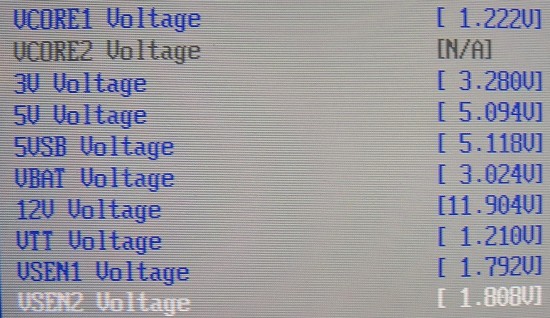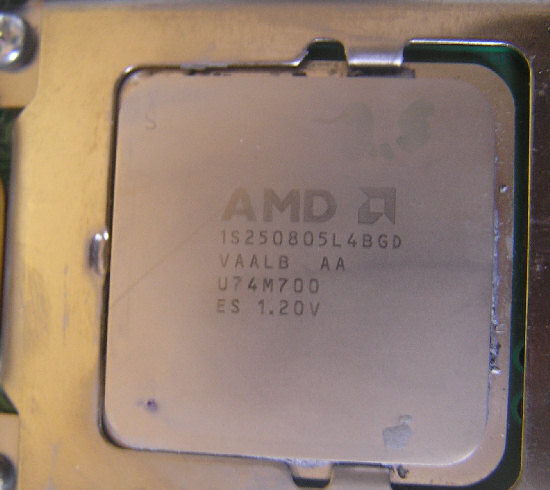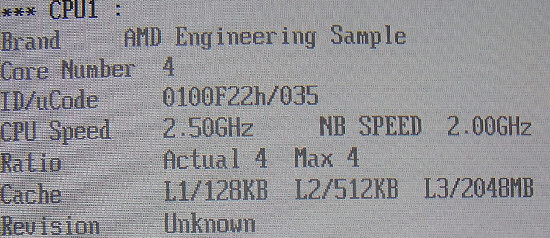AMD's 3rd generation Opteron versus Intel's 45nm Xeon: a closer look
by Johan De Gelas on November 27, 2007 6:00 AM EST- Posted in
- IT Computing
The Opteron 2360SE - the Facts
Getting back to AMD, the new quad-core chip still lives under veil of secrecy. Quite a few rumors and myths are going around and we investigated them one by one so we could be sure that you only get the facts.
Fact 1: The B2 stepping does not have a much faster memory controller than the B1 stepping
The controller found in stepping "2" might be a tiny bit faster, but we have not found any significant difference. Our Stream benchmarks were only a tiny bit faster on the 2.5GHz (Stepping 2) than on the 2GHz (Stepping DR-B1) and so were the latency numbers.

The 2.5GHz Barcelona is a newer stepping than the 2GHz sample we tested earlier.
Fact 2: The 2.5GHz review sample is running at 1.2V; it is not overclocked
CPU-Z reported that the chip was running at 1.5V, while the 2GHz quad-core was running at 1.2V.

Power measurements show that the BIOS of our ASUS board is accurate, but CPU-Z is not. The last evidence is of course the laser marking on the quad-core Opteron.

AMD is capable of producing 2.5GHz quad-core, but not in large quantities at this time. The 2.5GHz part should arrive at the end of this year, with large quantities expected in the first quarter of 2008.
Fact 3: the memory controller always runs RAM at the rated frequency
In this case, the new quad-core Opteron is completely different from what we have seen with previous Opteron (and Athlon 64) processors. In the first and second generation Opteron, the memory controller ran at a divisor of the CPU. This resulted in very odd memory clocks speeds at times, particularly on odd multipliers. For example, a 2.2GHz Opteron (11X multiplier) uses a divisor of 7 and ends up running DDR2-667 (333.5MHz clock) at 314MHz. That gives DDR2-628 instead of 667. In reality, this doesn't have any major performance impact, and it is only measurable with "Stream-like" benchmarks. In contrast, Barcelona's memory controller runs at its own frequency and will run the DIMMs at the rated speed.
Fact 4: By running the Northbridge at a lower speed, the new quad-core loses a bit of performance but saves power
The core of the Opteron 2360 runs at 2.5GHz, but the L3 cache runs at Northbridge frequency, which is 2GHz. It seems that AMD's engineers felt that running the L3 at core frequency would not have resulted in significantly higher performance, but significantly higher power dissipation. From another point of view, given a certain power envelope, running the Northbridge and the L3 cache at higher frequencies would result in lower core frequencies.

Fact 5: The L3 cache was a good choice, but…
The L3 cache does increase latency of accessing the main memory but decreases the average latency seen by the CPU. This leads to the question of whether the relatively slow L3 cache is really an advantage. The L3 cache has a latency of 43 cycles (2GHz) or 48 cycles (2.5GHz), but it's still quite a bit faster than system memory, which takes about 130 to 170 cycles to access.
In addition, it has one main advantage for server workloads. If more than one core is accessing a cacheline in the L3 cache, it will remain in the L3. If not, the L3 cache will behave like a fully exclusive cache: it will send the cacheline to the L1 and throw out the cacheline to make place for a "victim" of the L2. This allows relatively fast sharing of data between threads, which is important for large code footprint applications like database applications and others. For single-threaded applications, it looks like they get a 2.5MB L2 cache, although with an average latency of about 20 cycles.
Still, there is no doubt that the L3 cache of Barcelona could have been a bit bigger to score even better in the larger database benchmarks such as TPC. We have to guess that a larger L3 cache became a victim (pun intended) of the already large 283 mm² die size. Still, a 44 cycle latency (and more) is rather disappointing for only 2MB of L3 cache.
Fact 6: Dual-Link is possible with AMD 2xxx Opterons
Several readers asked us how it was possible that our ASUS KFSN4-DRE board linked our 2350 CPUs with two instead of one HyperTransport point-to-point connection, as the 23xx Opteron supports only one coherent HyperTransport link. However, the constraint is not the number of links but actually the number of coherent responses that are supported. Our ASUS board does feature twice as much bandwidth for CPU-to-CPU traffic (snoop, access to remote memory etc.)










43 Comments
View All Comments
befair - Friday, November 28, 2008 - link
ok .. getting tired of this! Intel loving Anandtech employs very unfair & unreasonable tactics to show AMD processors in bad light every single time. And most readers have no clue about the jargon Anandtech uses every time.1 - HPL needs to be compiled with appropriate flags to optimize code for the processor. Anandtech always uses the code that is optimized for Intel processors to measure performance on AMD processors. As much as AMD and Intel are binary compatible, when measuring performance even a college grad who studies HPC knows the code has to be recompiled with the appropriate flags
2 - Clever words: sometimes even 4 GFLOPS is described as significant performance difference
3- "The Math Kernel Libraries are so well optimized that the effect of memory speed is minimized." - So ... MKL use is justified because Intel processors need optimized libraries for good performance. However, they dont want to use ACML for AMD processors. Instead they want to use MKL optimized for Intel on AMD processors. Whats more ... Intel codes optimize only for Intel processors and disable everything for every other processors. They have corrected it now but who knows!! read here http://techreport.com/discussions.x/8547">http://techreport.com/discussions.x/8547
I am not saying anything bad about either processor but an independent site that claims to be fair and objective in bringing facts to the readers is anything but fair and just!!! what a load!
DonPMitchell - Friday, December 7, 2007 - link
I think a lot of us are intrigued by AMD's memory architecture, its ability to support NUMA, etc. A lot of benchmarch test how fast a small application runs with a high cash-hit rate, and that's not necessarily interesting to everyone.The MySQL test is the right direction, but I'd rather see numbers for a more sophisticated application that utilizes multiple cores -- Oracle or MS SQL Server, for example. These are products designed to run on big iron like Unisys multi-proc servers, so what happens when they are running on these more economical Harpertown or Barcelona.
kalyanakrishna - Thursday, November 29, 2007 - link
http://scalability.org/?p=453">http://scalability.org/?p=453kalyanakrishna - Thursday, November 29, 2007 - link
a much better review than the original one. But I still see some cleverly put sentences, wish it were otherwise.Viditor - Thursday, November 29, 2007 - link
Nice review Johan!On the steppimgs note you made, it's not the B2 stepping that is supposed to perform better, it's the BA stepping...
The BA stepping was the improved form for B1s, and the B3 stepping is the improved form of the B2. BA and B2 came out at the same time in Sept (though BA was the one launched, B1 was what was reviewed), B2 for Phenom and performance clockspeeds, BA for standard and low power chips.
Do you happen to have a BA chip to test (those are the production chips)?
BitByBit - Wednesday, November 28, 2007 - link
Despite K10's rather extensive architectural improvements, it looks likes its core performance isn't too different to K8. In fact, the gains we've seen so far could easily be attributable to the improved memory controller and increased cache bandwidth. It seems that introducing load reordering, a dedicated stack, improved branch prediction, 32B instruction fetch, and improved prefetching has had little impact, certainly far less than expected. The question is, why?JohanAnandtech - Wednesday, November 28, 2007 - link
Well, we are still seeing 5-10% better integer performance on applications that are runing in the L2, so it is more than just a K8 with a better IMC. But you are right, I expected more too.However, the MySQL benchmark deserves more attention. In this case the Barcelona core is considerably faster than the previous generation (+ 25%). This might be a case where 32 bit fetch and load reordering are helping big time. But unfortunately our Codeanalyst failed to give all the numbers we needed
BaronMatrix - Wednesday, November 28, 2007 - link
At any rate, it was the most in-depth review I've seen, especially with the code analysis. I too, thought it would be higher, but remember that Barcelona is NOT HT3 and doesn't have the advantage of "gangning\unganging." There was an interesting article recently that showed perf CAN be improved by unganging (maybe it was ganging, can't find it) the HT3 links.I really hate that OEMs decided to stand up to the big, bad AMD and DEMAND that Barcelona NOT have HT3 with ALL OF ITS BENEFITS.
I mean people complain that Barcelona uses more power, but HT3 would cut that somewhat. At least in idle mode, and even in cases where IMC is used more than the CPU or vice versa.
I also may as well use this to CONDEMN all of these "analysts" who insist on crapping on the underdog that keeps prices reasonable and technology advancing.
INSERT SEVERAL EXPLETIVES. REPEATEDLY. FOR A FEW DAYS. A WEEK. FOR A YEAR.
INSERT MORE EXPLETIVES.
donaldrumsfeld - Wednesday, November 28, 2007 - link
Conjecture regarding why AMD went quad core on the same die... and this has nothing to do with performance. I think one place where Intel is way ahead of AMD is package technology. Remember they were doing a type of Multichip module with the P6. Having 2 dice instead of a single die allows them to have an overall lower defect rate, higher yield, and higher GHz. This is vs. AMD's lower GHz but (it was hoped) greater data efficiency using an L3 die and lower latency of on-die communications amongst cores vs. Intel's solution of die to die communication.Can anyone confirm/deny this?
thanks
tshen83 - Tuesday, November 27, 2007 - link
Seriously, can you buy the 2360SE? Newegg doesn't even stock the 1.7Ghz 2344HEs.The same situation exist on the Phenom line of CPUs. I don't see the value of reviewing Phenom 9700, 9900s when AMD cannot deliver them. I have trouble locating Phenom 9500s.